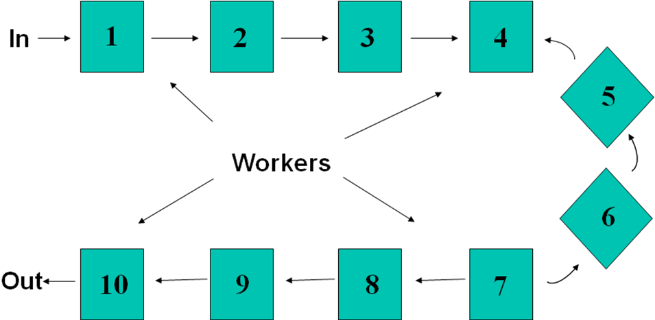Introduction
Layout design refers to the configuration of equipment, work centers, and departments, with a view of improving the flow of work in an organization. Therefore, planning of a layout involves decisions on how to arrange centers for economic activity required by facility’s processes (Domschke & Krispin, 1997). If an organization has an efficient layout, the operational costs and unnecessary material handling will be reduced significantly. In such an organization therefore, there shall be a maintained flow of product, information, and services/customers through the facility.
Application of Layout Designs in Organizations
Different types of organizations will employ certain layouts to ensure there is efficient (low cost) operation, minimal safety hazards and morale within the workers. The organizations below are discussed regarding the most efficient design to adopt.
In a high-end custom bicycle assembly plant, almost all variants in a specific model call for the same sequence of process. Therefore, a straight or u-shaped layout will serve the purpose of production in the most efficient manner. This layout ensures maximum utility of labor, lowers cost per unit, and increases the rate of assembly.

A value-added computer manufacturing company may adopt the Flexible Manufacturing System (FMS), which is an automated version of cellular manufacturing. In this system, there is a constant flexibility of small batch production due to the ability of transferring parts to various production stages using a control computer. Therefore, an FSM system has reduced costs due to less material handling and processing time.
Sugar mills normally employ highly standardized, repetitive processes since they produce high-volume and standardized products. Therefore, a product (straight layout) layout will be the most efficient in ensuring maximum output. Straight arrangements in mills ensure that the mills are not confined to space unlike those that use the balloon layout. In addition, this layout allows for generation of large volume of products in a short time keeping unit production costs at low levels. It also provides high-level efficiency in labor, and equipment utilization (Millington, 2004).

In a motorcycle company, the process layout is efficient due to the need for batch production. Several process machines are grouped according to their functions with those performing related function being grouped in one area. Depending on the model and stage of production, the process products are then taken through all the stages to completion. This layout has a great advantage since the company can be able to handle different processes at the same time thereby effectively reducing the cost of production.
Implications of Variety and Volume on Product Flow and Customer Service
When the variety of products in an organization is high while the volume low, there exists an intermittent product flow. On the other hand, a low variety and high volume of production results in a continuous flow of product. The layout of production is influenced by the process position of the variety and volume and also, the flow of transformed resources (Pycraft, Singh, & Phihlela, 2007). For example, where there exists a low variety of products or services with a high volume, material, information, and customer flow can become regularized making a product based layout the most appropriate for adoption(Pycraft et al., 2007).
To maintain good customer relationships where there are large volumes and varieties of goods, efficient layouts and technologies should be adopted. Such technologies and layouts will ensure workers are kept busy and as productive as possible. This will lead to an efficient customer service and subsequent improvement in the organization’s overall performance.
Conclusion
From the discussion above, I wish to conclude that for an organization to be efficient in production and provision of valuable services to customers it should: adopt an efficient layout for maximum operation; ensure appropriate ratios of products variety and volume; and finally, provide its workers with efficient technologies to allow for maximum product flow.
References
Domschke, W., Krispin, G. (1997). Location and Layout Planning. OR Spectrum, 19(3), 181-194.
Millington, C. (2004). Modern Cane Railways of Queensland. Mill Layouts and Yards, 8, 1-5.
Pycraft, M., Singh, H., & Phihlela, K. (2007). Operations Management. South Africa, SA: Pearson Education.